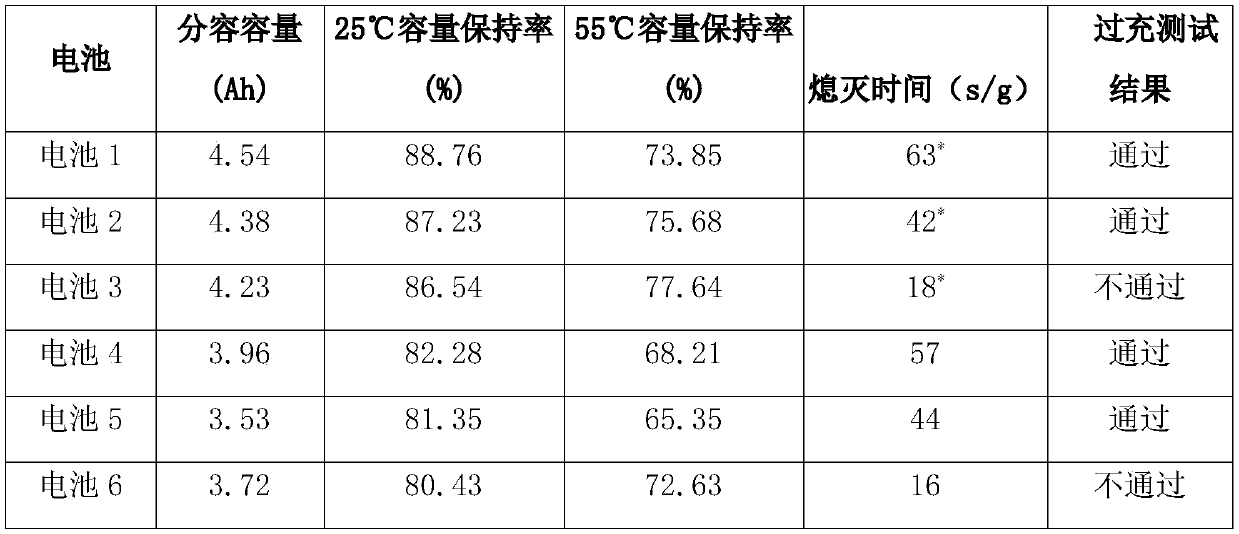A combined electrolyte and high specific energy silicon-based lithium ion battery containing the combined electrolyte
A lithium-ion battery, electrolyte technology, applied in secondary batteries, secondary battery repair/maintenance, circuits, etc., can solve problems such as failure to achieve results, and achieve the effects of avoiding negative effects, improving safety, and improving overall performance
- Summary
- Abstract
- Description
- Claims
- Application Information
AI Technical Summary
Problems solved by technology
Method used
Image
Examples
Embodiment 1
[0025] Preparation of Electrolyte 1 and Experimental Battery 1
[0026] (1) Preparation of positive electrode sheet
[0027] Mix the positive electrode active material NMC811 ternary material, conductive agent acetylene black, and binder polytetrafluoroethylene according to the mass ratio NMC811: acetylene black: polytetrafluoroethylene = 95:2.5:2.5, add N-methylpyrrolidone, fully Stir and mix to form a uniform positive electrode slurry, which is evenly coated on a 15-micron thick aluminum foil, and dried to obtain a positive electrode sheet.
[0028] (2) Negative sheet preparation
[0029] Negative electrode active material silicon oxide-graphite (SiO-C) negative electrode material, conductive agent acetylene black, binder styrene-butadiene rubber, thickener sodium carboxymethyl cellulose according to the mass ratio of silicon-based negative electrode material: acetylene black: butadiene Styrene rubber: thickener = 95:2:2:1 for mixing, add deionized water, stir and mix well...
Embodiment 2
[0037]The preparation of combined electrolyte 2 and experimental battery 2 is basically the same as the preparation process of combined electrolyte 1 and experimental battery 1 in Example 1, the only difference is that in step (3) component A is added to account for the entire combined electrolytic Liquid quality 10% fluoroethylene carbonate (FEC), 2% ethylene carbonate (VC); Component B adds trimethylsilane phosphite (TMSPi) accounting for 5% of the entire combined electrolyte mass; In part C, add cyclohexylbenzene (CHB) accounting for 5% of the mass of the entire electrolyte.
[0038] The final high specific energy silicon-based needle-ion battery is denoted as experimental battery 2.
Embodiment 3
[0040] The preparation of combined electrolyte solution 3 and experimental battery 3 is basically the same as the preparation process of combined electrolyte solution 1 and experimental battery 1 in Example 1, the only difference is that in step (3) component A is added to account for the entire combined electrolytic solution Liquid quality 5% fluoroethylene carbonate (FEC), 2% succinic anhydride (SA); Component B added trimethylsilane borate (TMSPi) accounting for 2% of the entire combined electrolyte mass; In part C, hexafluorocyclotriphosphazene (TFPN) accounting for 2% of the mass of the entire combined electrolyte was added.
[0041] The final high specific energy silicon-based needle-ion battery is denoted as experimental battery 3.
PUM
| Property | Measurement | Unit |
|---|---|---|
| diameter | aaaaa | aaaaa |
Abstract
Description
Claims
Application Information
 Login to View More
Login to View More - R&D
- Intellectual Property
- Life Sciences
- Materials
- Tech Scout
- Unparalleled Data Quality
- Higher Quality Content
- 60% Fewer Hallucinations
Browse by: Latest US Patents, China's latest patents, Technical Efficacy Thesaurus, Application Domain, Technology Topic, Popular Technical Reports.
© 2025 PatSnap. All rights reserved.Legal|Privacy policy|Modern Slavery Act Transparency Statement|Sitemap|About US| Contact US: help@patsnap.com



